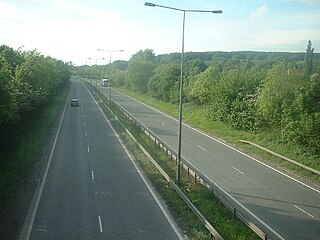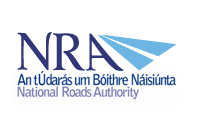
The A303 is a trunk road in southern England, running between Basingstoke in Hampshire and Honiton in Devon via Stonehenge. Connecting the M3 and the A30, it is part of one of the main routes from London to South West England, which runs to Land's End in Cornwall. It is a primary A road throughout its length, passing through five counties.

The A14 is a trunk road in England, running 127 miles (204 km) from the Port of Felixstowe, Suffolk to its western end at the Catthorpe Interchange; a major intersection at the southern end of the M6 and junction 19 of the M1 in Leicestershire. The road forms part of the unsigned Euroroutes E24 and E30.

Highways in Australia are generally high capacity roads managed by state and territory government agencies, though Australia's federal government contributes funding for important links between capital cities and major regional centres. Prior to European settlement, the earliest needs for trade and travel were met by narrow bush tracks, used by tribes of Indigenous Australians. The formal construction of roads began in 1788, after the founding of the colony of New South Wales, and a network of three major roads across the colony emerged by the 1820s. Similar road networks were established in the other colonies of Australia. Road construction programs in the early 19th century were generally underfunded, as they were dependent on government budgets, loans, and tolls; while there was a huge increase in road usage, due to the Australian gold rushes. Local government authorities, often known as Road Boards, were therefore established to be primarily responsible for funding and undertaking road construction and maintenance. The early 1900s saw both the increasingly widespread use of motorised transportation, and the creation of state road authorities in each state, between 1913 and 1926. These authorities managed each state's road network, with the main arterial roads controlled and maintained by the state, and other roads remaining the responsibility of local governments. The federal government became involved in road funding in the 1920s, distributing funding to the states. The depression of the 1930s slowed the funding and development of the major road network until the onset on World War II. Supply roads leading to the north of the country were considered vital, resulting in the construction of Barkly, Stuart, and Eyre Highways.

The A27 is a major road in England. It runs from its junction with the A36 at Whiteparish in the county of Wiltshire. It closely parallels the south coast in Hampshire, then passes through West Sussex and terminates at Pevensey in East Sussex.

A trunk road, trunk highway, or strategic road is a major road, usually connecting two or more cities, ports, airports and other places, which is the recommended route for long-distance and freight traffic. Many trunk roads have segregated lanes in a dual carriageway, or are of motorway standard.

The A259 is a road on the south coast of England passing through Hampshire, West Sussex, East Sussex and part of Kent. The main part of the road connects Brighton, Eastbourne, Hastings, Rye and Folkestone.

The National Roads Authority (NRA) was a state body in Ireland, responsible for the national road network. The NRA was established as part of the Roads Act 1993 and commenced operations on 23 December 1993 in accordance with S.I. 407 of 1993. The NRA merged with the Railway Procurement Agency and was effectively dissolved on 1 August 2015. The merger of the two agencies is called Transport Infrastructure Ireland (TII).

The Stonehenge road tunnel is a planned tunnel in Wiltshire, England drawn up by Highways England to upgrade the A303 road. It would move the A303 into a tunnel under the Stonehenge World Heritage Site, completing the removal of traffic begun with the closure of the A344 road. The wider project was designed to improve the landscape around the monument and to improve safety on the A303, and was part of proposals to change the site in other ways including moving the visitors centre.
Highways England Company Limited is the government-owned company charged with operating, maintaining and improving England's motorways and major A roads. It operates information services through the provision of on-road signage and its Traffic England website, provides traffic officers to deal with incidents on its network, and manages the delivery of improvement schemes to the network.

The United Kingdom has a network of roads, of varied quality and capacity, totalling about 262,300 miles (422,100 km). Road distances are shown in miles or yards and UK speed limits are indicated in miles per hour (mph) or by the use of the national speed limit (NSL) symbol. Some vehicle categories have various lower maximum limits enforced by speed limiters. Enforcement of UK road speed limits increasingly uses speed guns, automated in-vehicle systems and automated roadside traffic cameras. A unified numbering system is in place for Great Britain, whilst in Northern Ireland, there is no available explanation for the allocation of road numbers.
Transit New Zealand, which existed from 1989 to 2008, was the New Zealand Crown entity responsible for operating and planning the New Zealand state highway network. It also concerned itself with developments close to state highways, as it considered the potential additional traffic that these would create, and it was responsible for state highway landscaping.

The Longdendale Bypass is a long-planned road scheme in England by the Highways Agency. The aim is to alleviate traffic congestion on the A57 road/A628 road/A616 road routes that presently pass through the villages. There is both support and opposition for this long-planned scheme which will pass through the valley of Longdendale and part of the Peak District National Park.
Road protest in the United Kingdom usually occurs as a reaction to a stated intention by the empowered authorities to build a new road, or to modify an existing road. Protests may also be made by those wishing to see new roads built or improvements made to existing roads. Motivations for protests may be altruistic or selfish. In some cases, protests have also acted as a training ground for individuals and groups who continue to be active in campaigning and advocacy.

The Ministry of Communications, is a Cabinet-level ministry of the Pakistani Government responsible for analysing, formulating and implementing central policy on communications and transportation. It is the one of the oldest ministries, created August 14, 1947. The Ministry of Communications has jurisdiction over telegraph and telephone communications as well as public radio, technical means of radio and television broadcasting and the distribution of periodicals. The Ministry and its political executive, the Communications Minister, are headquartered in the Cabinet Secretariat, Islamabad Capital Venue. The Communications Minister is a public appointee who must be a member of Parliament. As of 17 December 2018, the Communications Minister is Murad Saeed.
The Ministry of Road Transport and Highways is a ministry of the Government of India, that is the apex body for formulation and administration of the rules, regulations and laws relating to road transport, transport research and in also to increase the mobility and efficiency of the road transport system in India. Through its officers of Central Engineering Services (Roads) cadre it is responsible for the development of National Highways of the country. Road transport is a critical infrastructure for economic development of the country. It influences the pace, structure and pattern of development. In India, roads are used to transport over 60 percent of the total goods and 85 percent of the passenger traffic. Hence, development of this sector is of paramount importance for India and accounts for a significant part in the budget. Since May 2014, the Minister for Road Transport and Highways is Nitin Gadkari.

The Catthorpe Interchange is a major intersection at the southern end of the M6, the western end of the A14 and junction 19 of the M1 near the village of Catthorpe in Leicestershire, England. It was developed in 1994 when the link to the A14 was added to the pre-existing M1/M6 junction by joining the M1, M6 and A14 to the country lane between Catthorpe and Swinford as part of the Trans European Road Network,.

A New Car Assessment Program is a government car safety program tasked with evaluating new automobile designs for performance against various safety threats.

Trunk roads in Wales were first created in the Trunk Roads Act of 1936 when the UK Ministry of Transport took direct control over 30 of the principal roads in Great Britain from English, Welsh and Scottish local authorities. The number of trunk roads were expanded from 30 to 101 in the Trunk Roads Act of 1946. These roads formed what the Act called "the national system of routes for through traffic". Since Welsh devolution the Trunk Road system in Wales has been managed by the South Wales Trunk Road Agent and North & Mid Wales Trunk Road Agent on behalf of the Welsh Government. As of April 2015, out of a total of 34,495 miles (55,514 km) of roads in Wales, 1,576 miles (2,536 km) are trunk roads.

Transport for the North (TfN) is the first statutory sub-national transport body in the United Kingdom. It was formed in 2018 to make the case for strategic transport improvements across the North of England. TfN brings together the North's nineteen local transport authorities and business leaders together with Network Rail, Highways England, and HS2 Ltd and works with Central Government.
















